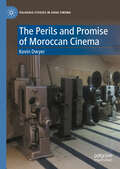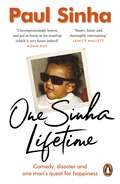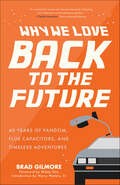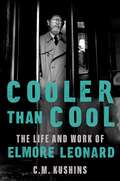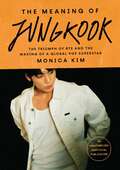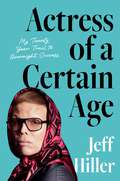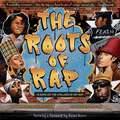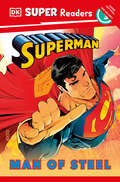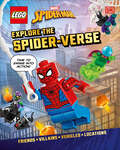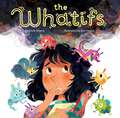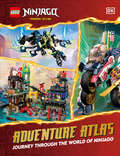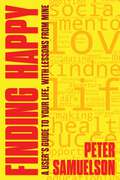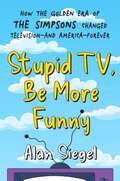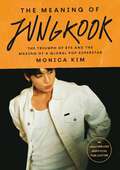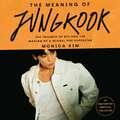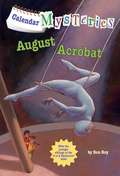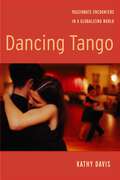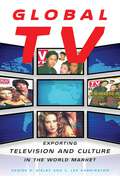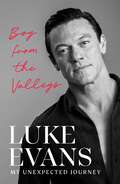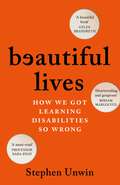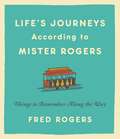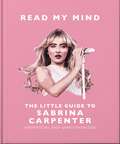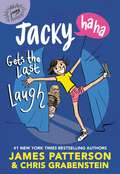- Table View
- List View
The Perils and Promise of Moroccan Cinema (Palgrave Studies in Arab Cinema)
by Kevin DwyerBased on extended field research and meetings with members of Morocco’s film world, this book traces the development of Moroccan cinema over the past three decades. Drawing from his extensive work on Moroccan cinema, Kevin Dwyer discusses important aspects of Moroccan film culture such as freedom of expression, the role of women, cultural diversity, the promotion of culture, the role of humor, the shifting emphasis on the urban, autobiographical aspects of films, and the development of documentary films. Dwyer closely analyzes a significant number of Moroccan films, providing crucial details about filmmakers; historical context; and comparisons with the cinemas of Tunisia, Algeria, and Egypt.
One Sinha Lifetime: Comedy, disaster and one man’s quest for happiness
by Paul Sinha'That night, I'd survived my life flashing before me, with my dignity intact. Yes, this chaotic life has always been a gamble.... But what a gamble.'Paul Sinha is an award-winning comedian, a quizzing mastermind and a happily-married husband. But for much of his life none of these seemed remotely imaginable.As a boy, Paul struggled to find his place in a world where he didn't quite fit. Who was he? An over-achieving schoolkid with the world's knowledge at his fingertips? A traditional Bengali son, destined for a career in medicine that he never once craved? A young gay man yearning to breathe freely? Or was he yet another flawed human being on a self-destruct mission?Amid life's mayhem, it was frequently Paul's love of facts in which he found solace, whether funding his lifestyle through quiz machines or simply trying to show off to his mates. Stumbling serendipitously into both a career in stand-up and a clandestine network of competitive quizzers introduced him to a new sense of purpose, a new identity, and, eventually, new love...A hilarious and moving coming-of-age memoir of one man's search for fulfilment, One Sinha Lifetime is an unconventional odyssey through love, family, and the joy of general knowledge.
Why We Love Back to the Future: 40 Years of Fandom, Flux Capacitors, and Timeless Adventures
by Brad GilmoreA Fan&’s Look at the Back to the Future Franchise&“Brad Gilmore's book not only offers new perspectives and a deeper understanding of Back to the Future, it reminds us why we fell in love with it in the first place." ─Mark Ellis, Comedian & Movie Critic#1 New Release in Science Fiction & Fantasy MoviesThere&’s a host of information out there on the Back to the Future trilogy, but never before has there been a book like this.The history of the films, cartoons, toys, and more. The Back to the Future series is a timeless collection greatly revered by all audiences. The beauty of this book by Brad Gilmore is that it doesn&’t present the history of the film as textbook information. He discusses these films from a place of passion and so effectively reveals how the history behind the movies is just as engaging as the films themselves. Unheard details and trivia. Gilmore, a radio and television host and host of Back to the Future: The Podcast, is an expert on all things Back to the Future. Pairing his knowledge with his passion for the films, Gilmore uses this book to discuss details and movie trivia that reveal just why the trilogy has stood the test of time. As a fan speaking to fellow fans, he dives into fan theories and provides answers to many questions readers have—because they are the very questions he himself has asked. Check out this must-have book and learn things you never knew: Completed timelines of all the main characters from the franchise In-depth studies of various Back to the Future fan theories that will surprise and intrigue you A detailed comparison of the films&’ predictions of the future to our world today Fans of books like Back to the Future: The Classic Illustrated Storybook, Back to the Future: The Ultimate Visual History, Back to the Future: Untold Tales and Alternate Timelines, or We Don&’t Need Roads: The Making of the Back to the Future Trilogy, will love Why We Love Back to the Future.
Cooler Than Cool: The Life and Work of Elmore Leonard
by C. M. KushinsDrawing on unprecedented archival and family access, Cooler Than Cool: The Life of Elmore Leonard, is the first comprehensive biography of the master American crime writer, author of witty, gritty bestsellers like Get Shorty and Raylan.Over the course of his sixty-year career, Elmore Leonard, “the Dickens of Detroit,” published forty-five novels that have had enduring appeal to readers around the world. Revered by Martin Amis, Margaret Atwood, Raymond Carver, and Stephen King, his books were innovative in their blending of a Hemingway-inspired noirish minimalism and a masterful use of realistic dialogue over exposition—a direct evolution spurred by his years as a screenwriter.Leonard’s fiction contained many layers, and at the heart of his work were progressive themes, stemming from his years as a student of the Jesuit religious order, his personal beliefs in social justice, and his successful battle over alcoholism. He drew inspiration from greats like Raymond Chandler and Dashiell Hammett, but the true motivation and brilliance behind his crime writing was the ongoing class struggle to achieve the American Dream—often seen through the eyes of law enforcement officers and the criminals they vowed to apprehend.C. M. Kushins tells Leonard’s full life story against recurring themes and evolving storytelling methods of his work, drawing on interviews with primary sources ranging from Leonard’s family and friends to those who acted in, produced, and directed his work onscreen. He also includes never-before-published excerpts from Leonard’s unfinished final novel and planned memoir. Definitive and revealing, Cooler Than Cool shows Leonard emerging as one of the last writers of the “pulp fiction” era of midcentury America, to ultimately become one of the most successful storytellers of the twentieth century, whose influence continues to have far-reaching effects on both contemporary crime fiction and American filmmaking.
The Meaning of Jungkook: The Triumph of BTS and the Making of a Global Pop Superstar
by Monica KimCelebrate Jungkook, the once-in-a-generation talent at the center of BTS, in this illuminating look into the forces that have made him a global icon.Jungkook is one of the world&’s biggest stars, period. His first album, Golden, sold more than 2 million copies on the day of its release and stayed on the Billboard 200 for twenty-four consecutive weeks. How did a young prodigy from South Korea make music history? The Meaning of Jungkook is an unofficial kaleidoscopic exploration of the forces that made Jungkook into the triumph he is today. The book does more than chronicle his humble beginnings in Busan and meteoric rise to fame. A lively narrative, it places Jungkook in a larger cultural and historical context, shedding light on the inner workings of the K-pop industry, internet culture, ARMY, and more. We learn that Jungkook&’s ruthless work ethic is a symptom of Korean culture and its singular pursuit for excellence; his style of dance places him in the lineage of Michael Jackson; and &“the soldout king&” has a unique visual appeal that meets high Korean beauty standards but also subverts it with his irreverent piercings and tattoos. Jungkook&’s success is not an accident. Talent and training, the livestreams and good looks, globalization and timing all contributed to the making of Jungkook, &“the Golden Maknae,&” the South Korean pop superstar who overcame the odds, and through his success, changed the status quo. This is an unauthorized elevated tribute to the singer, for both his fans and others interested in the genre. Monica Kim has delivered a tour-de-force, filled with vivid detail, that makes sense of the world of a music icon who has captured the devotion of millions of fans worldwide.
Actress of a Certain Age: My Twenty-Year Trail to Overnight Success
by Jeff HillerA humorous collection of autobiographical essays from comedian and Somebody Somewhere actor Jeff Hiller, who shares his journey from growing up &“profoundly gay&” in 1980s Texas to his experiences as an inept social worker and how he clawed, scraped, and brawled to Hollywood&’s lower middle-tier. While struggling to find success as an actor and pay the bills, something accidentally happened to Jeff Hiller: he aged. And while it&’s one thing to get older and rest on the laurels of success from the blood, sweat, and tears of your youth, it&’s quite another to be old and have no laurels. At forty, stuck in a temp job making spreadsheets, the dream of becoming a star seemed out of reach. But after twenty-five years of guest roles on TV and performing improv in a grocery store basement, he finally struck gold with a breakout role on HBO&’s Somebody Somewhere, playing Joel—the kind of best friend everyone wishes they had. In his book, Jeff dives into the grit and grind of climbing the Hollywood ladder. It&’s a raw and often hilarious tale of the struggles, triumphs, and humiliations that shaped him into the wonderfully imperfect person he is today. With a mix of awkward charm and heartfelt honesty, Jeff shares his journey: growing up very Lutheran in Texas, navigating bullying as a gay kid, working as a social worker for unhoused youth and HIV prevention, and the endless ups and downs of being a struggling actor. For every one of us who have a dream that we&’re chasing—and chasing, and chasing—his is a funny, moving, and utterly relatable story.
The Roots of Rap: 16 Bars on the 4 Pillars of Hip-Hop
by Carole Boston Weatherford"Carole Boston Weatherford, once again, delivers a resounding testament and reminder, that hip-hop is a flavorful slice of a larger cultural cake. And to be hip-hop-to truly be it-we must remember that we are also funk, jazz, soul, folktale, and poetry. We must remember that . . . we are who we are!" -Jason Reynolds, New York Times best-selling author"Starting with its attention-getting cover, this picture book does an excellent job of capturing the essence of rap . . . This tribute to hip hop culture will appeal to a wide audience, and practically demands multiple readings." ―Booklist, STARRED REVIEW"No way around it, this book is supa-dupa fly, with lush illustrations anchored in signature hip-hop iconography for the future of the global hip-hop nation." ―Kirkus Reviews, STARRED REVIEW"With short, rhyming lines and dramatic portraits of performers, the creative team behind How Sweet the Sound: The Story of Amazing Grace offers a dynamic introduction to hip-hop. . . . This artful introduction to one of the most influential cultural movements of the 20th century pulses with the energy and rhythm of its subject." ―Publishers Weekly, STARRED REVIEWExplore the roots of rap in this stunning, rhyming, triple-timing book, now available as a board book!A generation voicing stories, hopes, and fearsfounds a hip-hop nation.Say holler if you hear.The roots of rap and the history of hip-hop have origins that precede DJ Kool Herc and Grandmaster Flash. Kids will learn about how it evolved from folktales, spirituals, and poetry, to the showmanship of James Brown, to the culture of graffiti art and break dancing that formed around the art form and gave birth to the musical artists we know today. Written in lyrical rhythm by award-winning author and poet Carole Boston Weatherford and complete with flowing, vibrant illustrations by Corettta Scott King Award winner, Frank Morrison, this book beautifully illustrates how hip-hop is a language spoken the whole world 'round, and it features a foreword by Swizz Beatz, a Grammy Award-winning American hip-hop rapper, DJ, and record producer.
DK Super Readers Level 3 Superman Man of Steel (DK Super Readers)
by Matt JonesLearn how to read with the man of steel!Join Superman and his allies in Metropolis as they help save their city from Lex Luthor. Will Superman emerge victorious?Packed with fun facts, exciting color images, simple vocabulary, and a fun quiz, this Level 3 nonfiction reader will engage young fans of DC Super Heroes and help them build confidence in reading.
LEGO Marvel Spider-Man Explore the Spider-Verse
by DKThis edition does not include a minifigure.Grab your Spidey-Suit and explore the Spider-Verse in this first-ever LEGO® Marvel Spider-Man™ book!Discover a vast multiverse of spidery Super Heroes and their unique worlds in this fun and engaging guide to the world of LEGO Marvel Spider-Man. Learn about the vehicles and locations and meet amazing superstars like Peter Parker, Miles Morales, and Gwen Stacy – as well as lesser-known characters like Pork Grind and Scarlet Spider.Swing into action with LEGO Spider-Man as you explore the Spider-Verse:Features LEGO sets based on the Marvel Comics and films, showcasing a range of fan-favourite Spider-Man characters, vehicles, and locationsExplore LEGO Spider-Man’s world, gadgets, and suits as you find out more about the web-slinging hero and his friendsA wonderful gift for younger kids who love LEGO, Spider-Man, or both!Minifigure not included in this editionThis entry point to the Spider-Man multiverse is the perfect gift for young fans eager to know more about LEGO Spider-Man, giving them exciting facts and behind-the-scenes insights they won’t find anywhere else.© 2025 The LEGO Group© 2025 MARVEL
The Whatifs
by Emily Kilgore"Persico's atmospheric illustrations aptly reflect Cora's shifting emotions, and Kilgore successfully balances the whimsical with a tale grounded in reality." -Publishers Weekly"Cora and her Whatifs have a charming appeal beyond their focus on tackling anxious thoughts, making an enjoyable read-aloud for wide audiences. . . . A thoroughly welcome addition to growing collections of socio-emotional development materials." -Kirkus ReviewsCora is struggling with her Whatif questions ahead of a big piano recital in this timely picture book about overcoming anxiety.What if my dog runs away?What if I forget my homework?What if the sun stops shining?What if my crayon breaks?Cora is constantly worrying about everything. Because of this, the Whatifs love her. They sneak up to her and give her all kinds of doubts: big or small, silly or frightening, likely or impossible. As she prepares for an upcoming piano recital, the Whatifs cling on tighter and drag her down, making her anxious about messing up during the concert. Will she be able to change her worry-filled thoughts into hopeful ones?
LEGO Ninjago Dragons Rising Adventure Atlas: Journey Through the World of Ninjago
by DKThis edition does not include a minifigureJourney through the action-packed world of LEGO® NINJAGO® and discover everything there is to know about the mystical locations of the legendary Ninja!Take a tour across Ninjago, home of Spinjitzu and towering ninja temples. On your journey, you’ll visit popular restaurants, great rivers and deserts, dojos, and palaces – the land of Ninjago has it all!Discover the locations of the LEGO NINJAGO world in this exciting travel guide:Discover the mysterious realms of creation, from the sandy realm of Oni and Dragons to the dangerous Underworld realm, featuring travel guide-style reviews of each locationA great LEGO gift for young NINJAGO fans and collectors alikeMinifigure not included in this editionThe LEGO NINJAGO Dragons Rising Adventure Atlas features everything you need to know about the must-see sights of Ninjago, with reviews and ‘what to pack’ segments for would-be travelers. Stay sharp on your travels – you never know which characters or dragons you might bump into along the way!©2025 The LEGO Group.
Finding Happy: A User's Guide to Your Life, with Lessons from Mine
by Peter SamuelsonA master class for every Gen Z and Millennial to Find Happy in a dizzying worldAlmost everyone looks back on their youth and thinks, &“I wish I knew then what I know now.…&” This is a book for young adults who want to know right now what it is so many wish they had known back then. What is happy, anyway? Where do you find it? Finding Happy is for young adults starting their adult journey, and for those well into theirs who have not yet sighted land. It is written by a master storyteller who learned to scale walls and blew them up rather than be stopped, and who learned in the process that our happiness flows from leaving the world a better place than we found it. Ultimately, it&’s about how best to channel this glorious life we are each privileged to enjoy and to make it truly happy. Finding Happy is filled with gripping adventures and misadventures that demonstrate just how possible the seemingly impossible often is, from daredevil filmmaking in Africa and Asia to making daunting rules work for you, to earning a full college scholarship after being completely unable to answer the entrance exam essay question…to climbing down a hundred-foot pipe shaft at 3 a.m. to rescue a kitten, with no plan for how to climb back up. It is about how best to seize the day, which risks are brave and which foolish, about roadblocks and solutions, learning from leaders and finding your own secret sauce. Samuelson explains how to find your compass and persuade others to help you. He shows how to live your passion, make a living, take off your mask, build your best place in the universe, and find your own unique and personal Happy.
Stupid TV, Be More Funny: How the Golden Era of The Simpsons Changed Television-and America-Forever
by Alan SiegelThis comprehensive account of the meteoric rise of The Simpsons combines incisive pop culture criticism and interviews with the show&’s creative team that take readers inside the making of an American phenomenon during its most influential decade, the 1990s.The Simpsons is an American institution. But its status as an occasionally sharp yet ultimately safe sitcom that's still going after 33 years on the air undercuts its revolutionary origins. The early years of the animated series didn't just impact Hollywood, they changed popular culture. It was a show that altered the way we talked around the watercooler, in school hallways, and on the campaign trail, by bridging generations with its comedic sensibility and prescient cultural commentary. In Stupid TV, Be More Funny, writer Alan Siegel reveals how the first decade of the show laid the groundwork for the series' true influence. He explores how the show's rise from 1990 to 1998 intertwined with the supposedly ascendent post-Cold War America, turning Fox into the juggernaut we know today, simultaneously shaking its head at America's culture wars while finding itself in the middle of them. By packing the book with anecdotes from icons like Conan O&’Brien and Yeardley Smith, Siegel alaso provides readers with an unparalleled look inside the making of the show. Through interviews with the show's legendary staff and whip-smart analysis, Siegel charts how The Simpsons developed its singular sensibility throughout the &‘90s, one that was at once groundbreakingly subversive for a primetime cartoon and shocking wholesome. The result is a definitive history of The Simpsons' most essential decade.
The Meaning of Jungkook: The Triumph of BTS and The Making of a Global Superstar
by Monica KimJungkook is one of the world's biggest stars, period. His first album, Golden, sold more than 2 million copies on the day of its release and stayed on the Billboard 200 for twenty-four consecutive weeks. How did a young prodigy from South Korea make music history?The Meaning of Jungkook is an unofficial kaleidoscopic exploration of the forces that made Jungkook into the triumph he is today. This book does more than just chronicle his humble beginnings in Busan and meteoric rise to fame. A lively narrative, it places Jungkook in a larger cultural and historical context, shedding light on the inner workings of the K-pop industry, internet culture, ARMY, and more. We learn that Jungkook's ruthless work ethic is a symptom of Korean culture and its singular pursuit for excellence; his style of dance places him in the lineage of Michael Jackson; and "the soldout king" has a unique visual appeal that meets high, intensive Korean beauty standards but also subverts it with his irreverent style choices.Jungkook's success is not an accident. Talent and training, the livestreams and good looks, globalization and timing all contributed to the making of Jungkook, "the Golden Maknae," the South Korean pop superstar who overcame the odds, and through his success, changed the status quo. This is an unauthorized elevated tribute to the singer, for both his fans and others interested in the genre.Monica Kim has delivered a tour-de-force, filled with vivid detail, that makes sense of the world of a music icon who has captured the devotion of millions of fans worldwide.
The Meaning of Jungkook: The Triumph of BTS and The Making of a Global Superstar
by Monica KimJungkook is one of the world's biggest stars, period. His first album, Golden, sold more than 2 million copies on the day of its release and stayed on the Billboard 200 for twenty-four consecutive weeks. How did a young prodigy from South Korea make music history?The Meaning of Jungkook is an unofficial kaleidoscopic exploration of the forces that made Jungkook into the triumph he is today. This book does more than just chronicle his humble beginnings in Busan and meteoric rise to fame. A lively narrative, it places Jungkook in a larger cultural and historical context, shedding light on the inner workings of the K-pop industry, internet culture, ARMY, and more. We learn that Jungkook's ruthless work ethic is a symptom of Korean culture and its singular pursuit for excellence; his style of dance places him in the lineage of Michael Jackson; and "the soldout king" has a unique visual appeal that meets high, intensive Korean beauty standards but also subverts it with his irreverent style choices.Jungkook's success is not an accident. Talent and training, the livestreams and good looks, globalization and timing all contributed to the making of Jungkook, "the Golden Maknae," the South Korean pop superstar who overcame the odds, and through his success, changed the status quo. This is an unauthorized elevated tribute to the singer, for both his fans and others interested in the genre.Monica Kim has delivered a tour-de-force, filled with vivid detail, that makes sense of the world of a music icon who has captured the devotion of millions of fans worldwide.
Calendar Mysteries #8: August Acrobat (Calendar Mysteries #8)
by Ron RoyIt's a mystery every month from popular A to Z Mysteries author Ron Roy! With the younger siblings of the A to Z Mysteries kids!August is for Acrobat...In the eigth book of the Calendar Mysteries - an early chapter book mystery series - something special is coming to Green Lawn - a traveling circus! But when the performers arrive, they need help. Their show is a mess, and Bradley, Brian, Nate, and Lucy are happy to chip in. They fix up the equipment and find dazzling new acts, but what the show needs most is an acrobat. No one in town is brave enough to go up on the high trapeze, except for one mysterious masked person. If the kids could find out who it is, this might be the best circus ever - but it seems as if this acrobat doesn't want to be found! Parents, teachers, and librarians agree that these highly collectible chapter books are perfect for emerging readers and any kid who loves mysteries!
Dancing Tango: Passionate Encounters in a Globalizing World
by Kathy DavisArgentinean tango is a global phenomenon. Since its origin among immigrants from the slums of Buenos Aires and Montevideo, it has crossed and re-crossed many borders.Yet, never before has tango been danced by so many people and in so many different places as today. Argentinean tango is more than a specific music and style of dancing. It is also a cultural imaginary which embodies intense passion, hyper-heterosexuality, and dangerous exoticism.In the wake of its latest revival, tango has become both a cultural symbol of Argentinean national identity and a transnational cultural space in which a modest, yet growing number of dancers from different parts of the globe meet on the dance floor.Through interviews and ethnographical research in Amsterdam and Buenos Aires, Kathy Davis shows why a dance from another era and another place appeals to men and women from different parts of the world and what happens to them as they become caught up in the tango salon culture. She shows how they negotiate the ambivalences, contradictions, and hierarchies of gender, sexuality, and global relations of power between North and South inwhich Argentinean tango is—and has always been—embroiled.Davis also explores her uneasiness about her own passion for a dance which—when seen through the lens of contemporary critical feminist and postcolonial theories—seems, at best, odd, and, at worst, disreputable and even a bit shameful. She uses the disjuncture between the incorrect pleasures and complicated politics of dancing tango as a resource for exploring the workings of passion as experience, as performance, and as cultural discourse. She concludes that dancing tango should be viewed less as a love/hate embrace with colonial overtones than a passionate encounter across many different borders between dancers who share a desire for difference and a taste of the ‘elsewhere.’ Dancing Tango is a vivid, intriguing account of an important global cultural phenomenon.
Global TV: Exporting Television and Culture in the World Market
by C. Lee Harrington Denise D. BielbyA reporter for the Los Angeles Times once noted that “I Love Lucy is said to be on the air somewhere in the world 24 hours a day.” That Lucy’s madcap antics can be watched anywhere at any time is thanks to television syndication, a booming global marketplace that imports and exports TV shows. Programs from different countries are packaged, bought, and sold all over the world, under the watch of an industry that is extraordinarily lucrative for major studios and production companies.In Global TV, Denise D. Bielb and C. Lee Harrington seek to understand the machinery of this marketplace, its origins and history, its inner workings, and its product management. In so doing, they are led to explore the cultural significance of this global trade, and to ask how it is so remarkably successful despite the inherent cultural differences between shows and local audiences. How do culture-specific genres like American soap operas and Latin telenovelas so easily cross borders and adapt to new cultural surroundings? Why is The Nanny, whose gum-chewing star is from Queens, New York, a smash in Italy? Importantly, Bielby and Harrington also ask which kinds of shows fail. What is lost in translation? Considering such factors as censorship and other such state-specific policies, what are the inevitable constraints of crossing over?Highly experienced in the field, Bielby and Harrington provide a unique and richly textured look at global television through a cultural lens, one that has an undeniable and complex effect on what shows succeed and which do not on an international scale.
Boy From the Valleys: My unexpected journey
by Luke EvansFrom his humble beginnings in a quaint Welsh mining village to the dazzling lights of Hollywood, much-loved star, Luke Evans takes us on a poignant and inspiring journey that spans from the heart of Wales to behind the scenes of the global stage.Growing up in a small village in the Rhymney Valley, south Wales, Luke Evans’ early life was shaped by his Jehovah's Witness upbringing. While most children of his age spent their Saturday mornings watching Going Live on television, young Luke would dress in a suit and tie and join his parents to knock on doors to spread the word of his religion. From an early age, he felt different. This feeling of displacement was not limited to his faith; as he came to terms with his own sexuality, he also faced a difficult and uncertain path. In his poignant, tender and often humorous account, Luke shares his bold decision to leave home – and the religion – at seventeen to move to London, where the vibrant Soho scene captured his heart, invigorated his creative journey as an actor and opened a whole new world of opportunity.In finding himself, Luke also discovered his passions of singing, acting and performing. Starring first on the West End stages in iconic productions like Miss Saigon, Avenue Q and Rent, he quickly captivated the hearts of audiences and caught the eye of Hollywood's elite, going on to secure roles in blockbuster films such as The Hobbit, Beauty and the Beast, Fast and Furious and Dracula Untold.In this intimate memoir, Luke takes us behind the scenes of his career on the stage and screen. He writes beautifully of the relationship he now has with his family and the respect they all have for one another on their different paths. Luke's story is a powerful tale of resilience, courage, and the pursuit of finding a sense of belonging and identity, but mostly (and hopefully) a story of inspiration.
Beautiful Lives: How We Got Learning Disabilities So Wrong
by Stephen Unwin'This book is both heart-rending and gorgeous. It crosses the line many times but ultimately, it's about love. He teaches us humanity.' MIRIAM MARGOLYES'Thank you, Joey, for getting your dad off his arse to write this book.' HUGH BONNEVILLE'A beautiful book - powerful, persuasive, illuminating, moving.' GYLES BRANDRETH'This is a wonderful and important book. Beautifully written, of course; but full of pain and joy, concern and celebration.' SIMON RUSSELL BEALE 'A powerful, multi-faceted, myth-busting account of the most marginalised and belittled out-group in modern society.' SIMON JARRETT, author of Those They Called IdiotsFor much of history, people with learning disabilities have been regarded as unworthy of interest - often seen as a threat to the social order and sometimes dismissed as barely human. While recent years have seen an improvement, learning-disabled people are still treated as fundamentally different.Beautiful Lives is a personal and pragmatic account, told through the eyes of a father whose son has severe learning disabilities. From early civilisation to the chilling realities of twentieth-century eugenics, this powerful book uncovers a startling and rarely told history - one deeply embedded in the challenges still faced today.Unwin shapes this history into a powerful story of love, lived experience and the long struggle for a better future.
Life's Journeys According to Mister Rogers: Things to Remember Along the Way
by Fred RogersAn inspiring collection of thoughts to take with us on the paths we travel in life.For all the roads we choose to travel, and even those we don't, Fred Rogers has an observation, a story, some insights to share. Whether you're facing graduation, a new job, a new baby, marriage, any change in your life--expected or not--the wisdom that Mister Rogers offers can contribute mightily to the grace with which you handle the change.With sections titled Who You Are Right Now, Loving and Being Loved, and Guided Drift, Fred addresses the scope of human transitions. It all comes down to knowing we're valuable, and that we're worthy of that value. As Fred would say, "You don't have to be anything more than who you are right now."In her foreword, Joanne Rogers shares the Fred she knew. With stories from their life together, the joys as well as the struggles, Joanne shows how Fred looked at life as a journey--with the ups and downs and in-betweens.
Read My Mind: The Little Guide to Sabrina Carpenter
by Orange Hippo!With billions of streams, millions of fans and record-breaking achievements, Sabrina Carpenter has captivated hearts across the globe. With a journey that began on Broadway, flourished on Disney Channel's Girl Meets World and has landed in the music industry, Sabrina has catapulted to fame. In the past 12 months alone, Sabrina performed on 25 stops of Swift's phenomenally successful Eras tour and racked up more than five billion streams on Spotify - 10 billion in total! With chart-topping hits and dynamic roles in a range of films, the international star has become a beacon of inspiration for many - a role model with a genuine personality, relatable lyrics and unwavering dedication to her many crafts. The Little Guide to Sabrina Carpenter dives into the enchanting word of the multi-talented star, with inspiring quotes, intriguing facts and fascinating insights that celebrate the authentic passion of Sabrina and her extraordinary rise to stardom."It always feels good to put something you're proud of out in the world.""Confidence is the most beautiful thing you can possess."August 4, 2009:The day Sabrina posted her first ever video to YouTube. She was aged just 10 years old! The video was a cover of Taylor Swift's "Picture to Burn". It features Sabrina belting it out straight to camera, no frills, no effects, just pure singing talent in her homemade singing studio. It now has 1.7 million views.
Beautiful Lives: How We Got Learning Disabilities So Wrong
by Stephen Unwin'This book is both heart-rending and gorgeous. It crosses the line many times but ultimately, it's about love. He teaches us humanity.' MIRIAM MARGOLYES'Thank you, Joey, for getting your dad off his arse to write this book.' HUGH BONNEVILLE'A beautiful book - powerful, persuasive, illuminating, moving.' GYLES BRANDRETH'This is a wonderful and important book. Beautifully written, of course; but full of pain and joy, concern and celebration.' SIMON RUSSELL BEALE 'A powerful, multi-faceted, myth-busting account of the most marginalised and belittled out-group in modern society.' SIMON JARRETT, author of Those They Called IdiotsFor much of history, people with learning disabilities have been regarded as unworthy of interest - often seen as a threat to the social order and sometimes dismissed as barely human. While recent years have seen an improvement, learning-disabled people are still treated as fundamentally different.Beautiful Lives is a personal and pragmatic account, told through the eyes of a father whose son has severe learning disabilities. From early civilisation to the chilling realities of twentieth-century eugenics, this powerful book uncovers a startling and rarely told history - one deeply embedded in the challenges still faced today.Unwin shapes this history into a powerful story of love, lived experience and the long struggle for a better future.
Ultimate Beginner's Guide for Minecrafters: Unofficial Tips and Tricks to Survive and Thrive in the Overworld!
by Megan MillerThe most comprehensive guide available for new players learning the ropes of the world's most popular game—Minecraft! NOT OFFICIAL MINECRAFT PRODUCT. NOT APPROVED BY OR ASSOCIATED WITH MOJANG. Immerse yourself in a new, vibrant, delightful world—exploring, fishing, farming, fighting (if you want), fossil-hunting, and so much more. Unlike any other game world, in Minecraft, you can touch, pick up, and place pretty much anything you see, anywhere; you can travel as far as you want in any direction, from desert to ocean to snowy mountains and crystal caves; and you can create any structure, from a humble animal pen to a giant working rollercoaster, using just the blocks the world is made of. There&’s just so much to do in Minecraft that it&’s very easy to overlook some of the extensive and fantastic gameplay. This guide will show you how to survive and thrive in this deep, broad, and complex world. It&’s chock full of pro tips, challenges, and step-by-step instructions that will get you on the ground and running—and sneaking, boating, swimming (or even flying with rare elytra wings)! From how to find or build a simple shelter on your first night, to finding exotic hidden temples (and loot) and dimensions, this guide will step you through the must-know basics, including: What to do on your first day (and second, and third, and more!)The important places to visit and lootHow to travel and what to bring with youHow to avoid getting lostHow to gain the upper hand with skeletons, zombies, and other creepy mobsThe sturdiest and strongest weapons and tools to craftHow to build and destroy (TNT anyone?)The best way to mine for precious diamondsWhere to go if you like a battle (and how to avoid them!)How to find the hidden dimensions (and denizens) like the Nether and the EndPro tips, challenges, and step-by-step activities to get you in the groove
Jacky Ha-Ha Gets the Last Laugh (Jacky Ha-Ha #3)
by James Patterson Chris GrabensteinJacky Ha-Ha is off to theater camp and funnier than ever in this hilarious illustrated novel from James Patterson and Chris Grabenstein's #1 New York Times bestselling series. Jacky Hart finally knows the thrill of having people laugh with her (not at her). She tries to put her comedy and theater skills to use in her summer job, but the boardwalk crowds aren&’t exactly adoring. So Jacky jumps at the opportunity of a lifetime: an all-expense paid trip to theater camp! When Jacky gets to Camp Footlights, she realizes she&’s way out of her depth. The highly trained campers all seem to know everything about performing, and exactly how to command the spotlight. All Jacky wants is to prove she fits in, but the more she tries, the more she stands out—and not in a good way. With help from her new friends, can Jacky Ha-Ha earn her place in the spotlight…or will she flop? Packed with illustrations, jokes, and hijinks, the latest book in the #1 bestselling Jacky Ha-Ha series delivers a hilarious and heartwarming dose of summer fun, perfect for reading all year round!
